 |
 |
 |
 |
 |
 |
 |
 |
 |
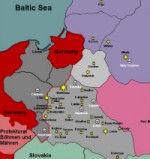 |
| Ghettos |
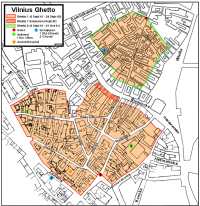 |
| Vilnius Ghetto Map |
Today Vilnius is the capital of the Republic of Lithuania. Known to Jews as Vilna (Wilna) and to Poles as Wilno, the city once was known as the "Jerusalem of Lithuania". Out of a population of approximately 196,000 in 1931, 28% or 55,000 were Jewish. This figure has been estimated to have risen to 57,000 by September 1939. Due to an influx of refugees, the Jewish population had swollen to at least 80,000 by June 1941.
Once part of the Russian Empire, on 16 February 1918 the Lithuanian Council in Vilnius proclaimed an independent Lithuanian Republic. In the autumn of 1920, Vilnius and the region to which it belonged were occupied by Poland. On the outbreak of WW2 in 1939 Lithuania, originally to be occupied by Germany as part of the secret protocol, attached to the Ribbentrop-Molotov pact, was ceded to the Soviet Union in exchange for German occupation of central Poland, which had initially been allocated to the USSR.
The Red Army occupied Vilnius on 19 September 1939. Lithuania and the Soviet Union signed a treaty of mutual aid, in accordance with which Vilnius and the Vilnius region were returned to Lithuania. In 1940, Vilnius became the capital of Soviet Lithuania.
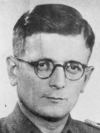 |
| Weiss * |
On 8 July 1941 an order was issued stating that all Jews must wear a special patch on their back; subsequently they were ordered to wear the patch on their chest. The commandant of the town of Vilnius, Zehnpfennig, signed this order. But two days later another commandant named Neumann ordered that the Jews should not display these patches, but must instead wear the yellow Star of David.
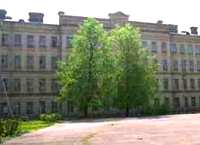 |
| Lukiszki Prison * |
The first shootings of Jews in Vilnius occurred on 4 July 1941 (or even earlier), after the military administration was replaced by a civil administration. On the same date the Germans ordered the establishment of a Judenrat (Jewish Council) which was intended to control the Jewish ghetto police and various departments of: work, health service, social welfare, food, housing, etc. Of special importance was the department of work. The Judenrat considered that as long as the Jewish workforce was of use to the Germans, the ghetto would not be liquidated. This was a kind of warranty, allowing Jews to retain some hope of continued existence and eventual survival. Almost all men and women of suitable age and fitness were employed in different factories and workshops, but were often also impressed for forced labour.
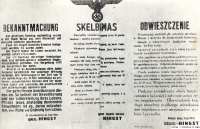 |
| Curfew |
Between the time of the German occupation of the city and the creation of the ghettos on 6 September 1941, 20,000 Jews either vanished or were killed (approximately 7,000) outright. By the end of 1941, the murdered Jews of Ponary numbered at least 48,000, the majority of them from Vilnius.
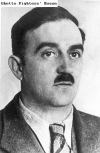 |
| Anton Schmidt * |
It has been estimated that between one-half and two-thirds of all Lithuanian Jews were killed by local militia, although it should be said that there were also some Lithuanians as well as Germans who assisted Jews. Even if few in number, their courage serves to highlight the barbaric acts of their compatriots. One Austrian soldier in particular, Anton Schmidt, hid Jews in the basement of a mattress workshop and arranged for their transfer to Byelorussia in military trucks. He was executed for his actions.
Between end of July and early August 1941, Lithuania was transferred from military rule to the Reichskommissariat Ostland.
The killings continued at Ponary in the following weeks without respite. By 1 December 1941, Einsatzkommando 3 had raided Vilnius no less than fifteen times. Einsatzkommando 9 assigned 150 of their Lithuanian auxiliaries to participate in the liquidation of the Jewish community. Every morning and afternoon they seized 500 people, who were murdered the same day. The victims were not only Jews of Vilnius: Jewish residents of many nearby towns and villages as well as Polish priests and Russian POWs were murdered there. Nor was Ponary the only murder site; hundreds died in the Lukiszki prison in Vilnius itself.
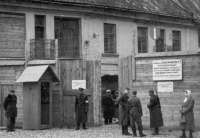 |
| Ghetto Gate |
On 1 September 1941, 4,000-5,000 (3,700 - according to EK3 chief SS-Standartenführer Karl Jäger) Vilnius Jews were herded together by the Germans. An endless column walked through the nocturnal streets. Nearly nobody knew what would happen to them. One day later, on 2 September 1941, the witness Sakowicz saw them arriving at the Ponary killing site. Only two girls survived this massacre by crawling out of the pits: the 16 years-old Pesia Szlos and the 11 years-old Judyta Trojak.
After 3 September 1941, six survivors are known to have crawled out of the pit alive. All of them were girls or women. Dvorjetsky related the woman’s story to a gathering of Vilnius' Jews. They refused to believe him, accusing him of panic mongering. The Aktion continued for four days, resulting in 8,000 deaths.
 |
| Ghetto Street * |
Two ghettos were installed, separated by Niemiecka Street. This street was outside the limits of both ghettos and served as a barrier between them. A wooden fence enclosed each ghetto, and the entrances of houses facing the outside were blocked off. Each ghetto had only one gate for exit and entry, placed at opposite ends of the enclosed area, so that it would be impossible for those entering and leaving to cross paths. At first, people were moved into either ghetto at random. 29,000 people were incarcerated in Ghetto 1 and 9,000-11,000 in Ghetto 2. The living conditions were those common to the ghettos of countries under Nazi occupation - dilapidated housing, lack of sanitation, unbearable congestion. A doctor calculated that in the 72 buildings, which comprised Ghetto 1, the average living space was 1.5-2 square meters. The killing never stopped. Even on the day of the setting up of the ghettos, a day on which it was intended to lull the Jews into some sense of security, killings had taken place. Every day in September 1941 Jews continued to be slaughtered by Einsatzkommando units.
Several days after the Jews had moved in, Ghetto 1 was designated for craftsmen and workers with permits, and Ghetto 2 was to be for all others. The transfer of orphans, the sick, and the elderly from Ghetto 1 to Ghetto 2 began. Those with work permits moved with their families into Ghetto 1. On 15 September 1941, the ghetto police published a notice stating that those without work-permits would have to move to Ghetto 2 to alleviate congestion. That night approximately 3,000 people started towards the second ghetto; only 600 reached its gate. The rest were taken to Lukiszki prison and then Ponary, where they were murdered.
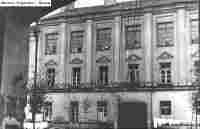 |
| Judenrat Building * |
In the period from 15 September to 21 October, families in which neither parent was employed were transferred into Ghetto 2. The other Jews were put into Ghetto 1. It was during this period that the "Yom Kippur Action" took place, on 1 October 1941. 3,000 Jews were deported to Ponary. In three more "actions", on 3-4, 15-16, and 21 October, Ghetto 2 was liquidated and its inhabitants murdered at Ponary.
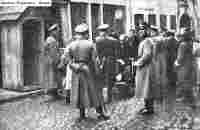 |
| Gelber Schein Supervision * |
On 24 October 1941 and 3 November 1941 the Gelbschein Aktionen took place, claiming the lives of a further 9,000 victims who held no permit. This was followed in December 1941 by further smaller "actions". In addition 3,500 Jews had fled from Vilnius to Byelorussian towns and villages, or had hidden outside the ghetto. The official "legal" population of the ghetto was now 12,000. In reality there were at least a further 3,000 "illegals" in hiding, in the ghetto or on the "Aryan" side.
There now followed a period of relative quiet in the ghetto, lasting until summer of 1943. Vilnius became a "working ghetto". The Judenrat’s policy of "rescue through work" was based on the assumption that if the ghetto would be productive, it would be worthwhile for the Germans to keep it going, for economic reasons. In this it shared a belief common to the Judenrat of many other ghettos. All sought, in their different ways, to preserve the precarious balance between work and death. Daily, they were faced with the same devastating choices, which had faced the holders of a Schein. Their responses to the desperate position in which they were placed are amongst the most controversial aspects of the Holocaust. Some were admired for their passive resistance, insofar as that was possible, others were despised for their presumed collaboration.
Few Jews wanted to be members of the Jewish councils. The Judenräte were instruments by which the Germans held control over the Jews. Since the council's functionaries were Jewish, the members felt as if they were betraying their co-religionists. The Vilnius Judenrat was initially established with extreme difficulty, as those who were selected as members by Rabbi Simeon Rosowski refused the position. Thus, the decision was made at a meeting in the prayer house, that if someone was elected, they were obligated to accept.
The first Jewish underground organisation calling for armed revolt against the Germans was formed in the ghetto on 1 January 1942. Under the leadership of Yitzhak Witenberg, the "United Partisans Organisation" (FPO - Fareinikte Partisaner Organizatzie) was a combination of Communists and various Zionist organisations. Their first proclamation was unusually prescient: "All the roads of the Gestapo lead to Ponary. And Ponary is death! ... Hitler aims to destroy all the Jews of Europe. The Jews of Lithuania are fated to be the first in line. Let us not go as sheep to the slaughter!" But whilst a core of activists continued to attempt to rouse the population to fight their persecutors, there was no effective armed resistance in Vilnius.
Hear the hymn of the FPO
See our page about Hirsh Glik.
 |
| Jacob Gens * |
On 10 July 1942, the SS appointed Gens as the head of the ghetto, dissolving the Judenrat. Fried was appointed deputy head. Gens craved office and the trappings of office. There were probably elements of megalomania in his personality; ghetto residents referred to him as "King Jacob the First", although there is no doubt that he believed passionately in the philosophy expressed in the slogan "work for life". Eventually 14,000 out of 20,000 residents in the ghetto were in employment. By September 1942, the Judenrat itself employed 1,550 people, more than 10% of the then "legal" population of the ghetto.
Judaism taught that if it was demanded that one Jew be unjustly surrendered to an enemy in order to be put to death otherwise all Jews would be killed, the Jews should all suffer death rather than surrender one of their number. In many ghettos, rabbis wrestled with this moral problem. Few dissented from the traditional view. But for those burdened with the terrible choices, Halacha (Jewish law) was no answer to the unprecedented nature of the Holocaust.
During the selections of October and November 1941 Gens himself checked the papers of the Jews as they passed before him, three blue cards to one yellow card. In October he participated in the Aktion that removed about 150 old and incapacitated Jews from the ghetto. In two "actions" in December he supervised the delivery of over 150 Jewish "criminals" to Ponary.
In October 1942, Gens, who was also responsible for several smaller surrounding ghettos, sent his deputy to the Ozmiana Ghetto to choose 400 elderly and chronically ill people to be killed. The Germans had demanded 1,500 for transportation to Ponary. Gens believed that by helping to supervise the "actions", a proportion of those who would otherwise be killed might be saved. Justifying his "actions", Gens said:
"The Jewish Police saved those who must live. Those who had little time to live were taken away and may the aged among the Jews forgive us. They were a sacrifice for our Jews and our future."
On another occasion he defended himself, saying:
"When they ask me for a thousand Jews, I hand them over; for if we Jews will not give them on our own, the Germans will come and take them by force. Then they will take not one thousand, but thousands. With hundreds, I save a thousand. With the thousands that I hand over, I save ten thousand. I will say: I did everything in order to save as many Jews as possible…..to ensure that at least a remnant of Jews survive."
Gens was aware of the resistance, but tolerated it only as a means of last resort. His primary concern was to maintain the policy of survival through work. Anything that interfered with that strategy was not to be tolerated. So when, on 16 July 1943, the Germans discovered Witenberg’s identity and demanded his surrender with the threat that they would otherwise burn the ghetto to the ground, Gens summoned the Jews of the ghetto and announced that because of Witenberg the ghetto might be annihilated. Chaos broke out, with Jews attacking the partisans and demanding that Witenberg be handed over to the Germans. After consultation with his colleagues, Witenberg surrendered to the Gestapo. Some accounts suggest that Gens had given Witenberg a cyanide pill; others report that he was immediately shot and that his mutilated body was found the next day. Abba Kovner, his successor as leader of the FPO, later declared that Witenberg’s surrender was a heroic act, preventing a conflict between Jew and Jew.
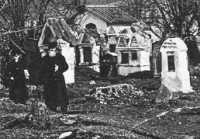 |
| The Old Cemetery * |
By then, the final death throes of the Vilnius Ghetto had begun in accordance with Himmler's order of 21 June 1943 to liquidate the ghettos of the Reichskommissariat Ostland. All provincial work camps of the Vilnius Ghetto (in Baltoji Voke, Beznodys, and Kena) were dissolved, and several hundreds of their prisoners killed by the German police.
Following the transfer of Jews from smaller neighbouring ghettos, in the summer of 1943 there were in excess of 20,000 Jews in the Vilnius Ghetto, 12,332 of whom were counted as workers. By 5 September 1943, a further 7,000 Jews had been sent to Ponary and murdered. In "actions" on 4 and 24 August, and 1 and 4 September, over 7,000 men and women, capable of working, were sent to labour camps at Vayvari and other places in Estonia. The FPO called in vain on the ghetto to revolt.
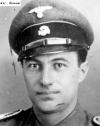 |
| Bruno Kittel * |
Now came the task of destroying the evidence. Paul Blobel and his Einsatzkommando was ordered to perform this task. He arrived in the end of September 1943.
By 25 September 1943, only 2,000 Jews officially remained in Vilnius, in four small labour camps. More than 1,000 were in hiding inside the ghetto. Those in hiding were gradually hunted down and executed. Those permitted to live continued to work at the Kailis factory (fur factory) and the HKP 562 (Heeres-Kraftfahr-Park / Military Vehicle Repair Park) workshops which were situated at several locations in Vilnius.
Immediately after the retreat of the Wehrmacht from Vilnius and the abandonment by them of the HKP workshops on 2 July 1944 the SS took 1,800 of the prisoners to Ponary and shot them. A small number of the workers remained in hiding until the Red Army entered Vilnius on 13 July 1944.
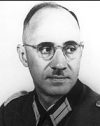 |
| Karl Plagge * |
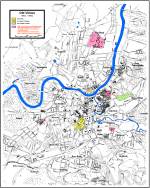 |
| Vilnius Map (560 KB!) |
Ultimately 250 of the HKP Jews survived until liberation because Plagge had warned them that SS killing squads were coming. It was the single largest group of Jewish survivors from Vilnius during the Shoah. On 11 April 2005, after years of research by HKP survivors and their descendants, Karl Plagge was awarded the title of "Righteous Among Nations" by Yad Vashem in Jerusalem.
(More about Karl Plagge in German and English!)
Between 2,000 and 3,000 of the original 57,000 Jewish inhabitants of Vilnius survived, either in hiding, with the partisans, or in camps in Germany and Estonia, a mortality rate of approximately 95% - almost exactly corresponding with that of Lithuania as a whole. The 2001 census indicated that the population of Vilnius was 542,287, of whom 0.5% or about 2,700 were Jews.
In post-war trials of the major war criminals of Vilnius, Franz Murer, the "expert on Jewish affairs" in the city from 1941 to 1943, also called by survivors "The Butcher of Vilnius" was arrested in 1947 and extradited to the Soviet Union. There he was sentenced to 25 years hard labour. In 1955 he was released and returned to his native Austria, where he became a farmer. He was eventually traced by Simon Wiesenthal. A further trial took place in Austria in 1967, at the conclusion of which Murer was acquitted. Martin Weiss, who had personally participated in the murders at Ponary, was tried in 1950, and sentenced to life imprisonment, as was August Hering, head of the Sonderkommando in Vilnius from January to June 1942. Bruno Kittel, who had supervised the liquidation of the Vilnius ghetto, disappeared at the end of the war. Soviet courts tried some Lithuanians. Most perpetrators were never prosecuted.
See The Memoirs of Samuel Esterowicz
Sources:
Atlas of The Holocaust - Martin Gilbert - William Morrow and Company Inc, New York 1993.
The Holocaust - Martin Gilbert - Collins, London 1986.
The Holocaust in Lithuania - Dina Porat - The Final Solution - Origins and Implementation - David Cesarani (Ed) - Routledge, London 1996.
The War Against The Jews - Lucy S Dawidowicz - Bantam Books, New York 1979.
The Good Old Days - The Holocaust as Seen by Its Perpetrators and Bystanders - Ernst Klee. Willi Dressen and Volker Riess - Konecky & Konecky, New York 1991.
The Destruction of the European Jews - Raul Hilberg - Yale University Press, New Haven 2003.
Ghetto in Flames - Yitzhak Arad - Yad Vashem - Jerusalem 1980.
Judenrat. The Jewish Councils in Eastern Europe Under Nazi Occupation - Isaiah Trunk - The Macmillan Company - New York 1972.
Encyclopedia of the Holocaust - Israel Gutman (Ed) - Macmillan Publishing Company - New York 1990.
Belzec, Sobibor, Treblinka - The Operation Reinhard Camps - Yitzhak Arad - Indiana University Press - Bloomington and Indianapolis 1987.
Documents on the Holocaust - Yitzhak Arad, Israel Gutman, Abraham Margaliot (Eds) - University of Nebraska Press - Lincoln 1999.
Testimony of Abram Gerzevitch Suzkever - International Military Tribunal - Nürnberg 1946.
Michael Good www.searchformajorplagge.com
Die geheimen Notizen des K. Sakowicz - Margolis, Rachel and Tobias, Jim G. (Eds) - Antogo Verlag - Nürnberg 2003.
Liquidation of Wilno Ghetto - Belberyszski, Mendel - in: "Dokumenty i materialy" of CZKH (Jewish Central Historical Commission), Vol. II - Akcje i wysiedlenia (Actions and Deportations)", Lodz 1946.
Photos:
GFH *
Yad Vashem *
www.noarfamily.com/Vilnaghetto *
© ARC (http://www.deathcamps.org) 2005